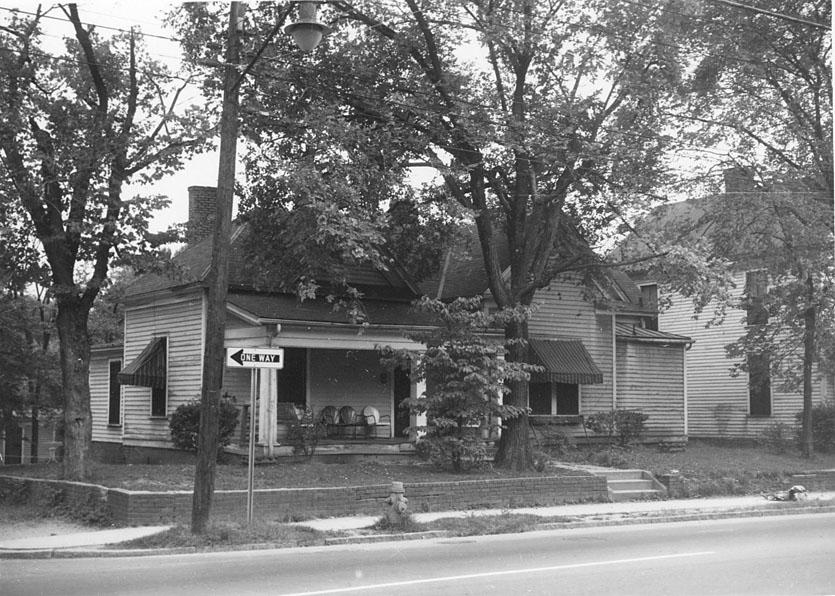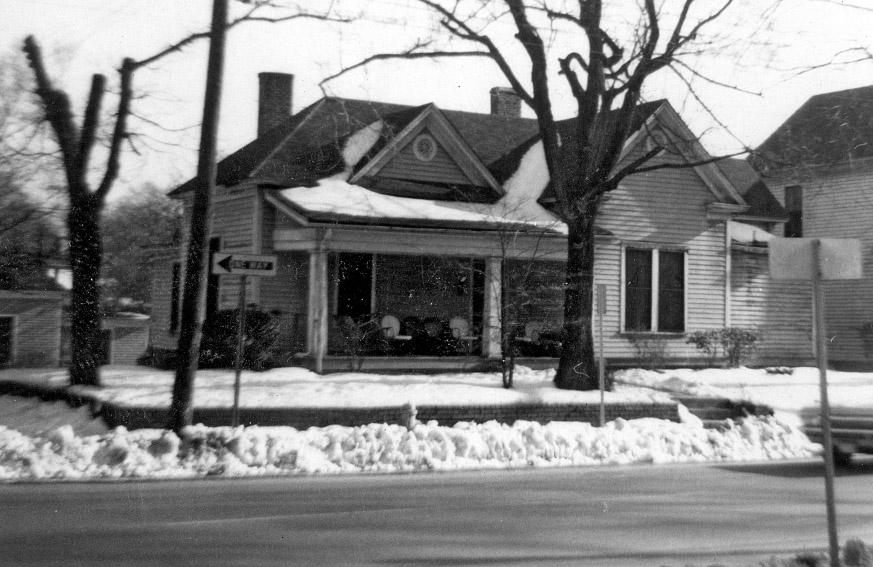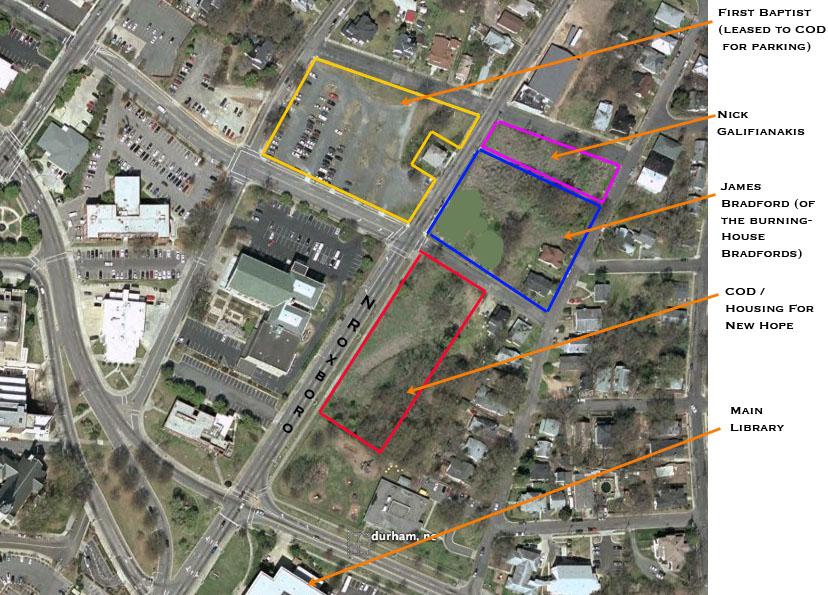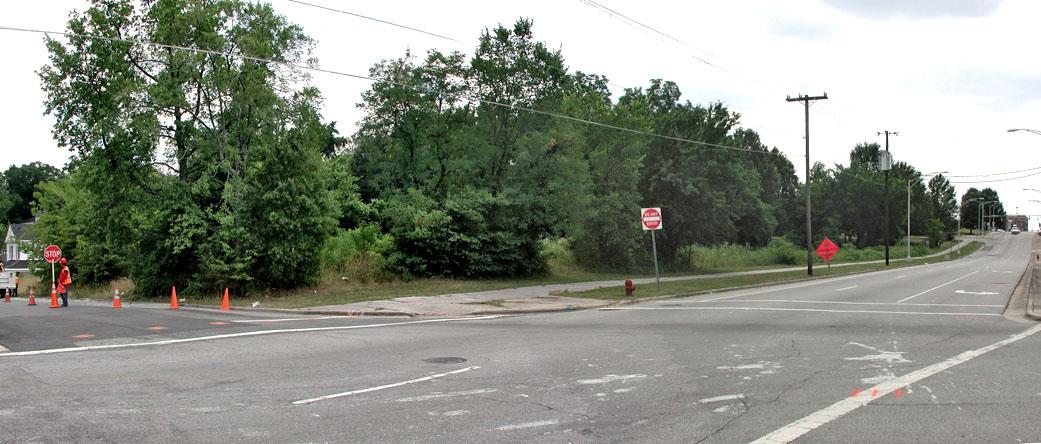426 Roxboro, looking ~east., 1963
February 1966
So, as of 2007, the deal between the city and Housing for New Hope to essentially donate the eastern side of the 400 block of North Roxboro to the non-profit to construct a "10 unit apartment building for the homeless" is now public, in yesterday's Herald-Sun, which refers to the land as "nearly unusable." The catch in the 1 dollar deal is that the land has a steep drop-off and has a stream-path, likely subject to Neuse buffers.
The article in the Herald-Sun fails to mention that the "nearly unusable" land was not useless until the city seized and demolished the 10 houses on this block as part of the urban renewal program in 1968.
Looking southeast from Roxboro and Elliott/Seminary, 2007.
This small area does not need another exclusively low-income/homeless housing facility. There are a bevy of such facilities / housing within a ~6 block radius from the intersection of Holloway and Dillard. The word on the street, although I've been unable to definitively confirm it, is that the city is entering into another $1 deal for the large vacant parcel at Dillard and Holloway, one block away, to build "housing for at-risk youth".
While the Feds recognized the mistake of highly concentrated neighborhood poverty, and adopted an economic diversity model for their HOPE VI program (an excellent program, now defunded - thanks to our current administration), the proliferation of multiple non-profits devoted to building low-income housing, and the availability of government money to fund their efforts has led to a competitive building frenzy by low-income housing producers. The lack of any small-area planning in Durham means that concentration where land is cheaper (or given away by the government, which is likely to occur where land is cheap) is a foregone conclusion, particularly when your city lacks inclusionary zoning or other policy to bring affordable housing to the suburbs.
The struggle here is that providing for the failure of the private housing market is a good thing; we need housing options for people who cannot participate in that market. But you can have too much of a good thing. Some low-income housing advocates I speak with view the housing market in only those broad terms - they are fighting the good fight against the outpricing of low-income folks, and they must build as many as possible to keep up with that outpricing.
But when that housing is concentrated in a small area, it essentially recreates some of the fundamental problems of housing projects - significant poverty, concentrated in a very small area, brings externalities. Home ownership is not a panacea, particularly when low-income residents may lack the funds for upkeep.
What is our affordable housing deficit in the city of Durham? No one knows. Do we have an affordability problem, or simply a housing/neighborhood quality problem (when houses are selling for $30K in East Durham, perhaps affordability isn't the issue.) How many units do we need - does Self-Help need to build 20 units of low-income housing in West End per year in perpetuity, as is their plan? No one is minding the store on location of government-funded housing by non-profits.
This is another one of those issues that people avoid discussing - some conservatives find subsidized housing/government involvement in the housing market an anathema and tell you the whole business is a waste - get some vouchers. Some liberals will excoriate with invectives of classism, callousness or racism for even discussing the possibility that there could be too much low-income housing.
Both of which avoid the difficult issue - the private housing market persistently fails for low-income people - in part because poverty can bring externalities of its own. We need affordable units - but the goal is to create mixed-income neighborhoods, with enough capital to fight for themselves, but enough affordability to provide for low-income residents. Because what is happening now is economic segregation - rich enclaves in one part of town, and the government-subsidized creation of the new ghettos in another part of town.
Some are all too happy to build endless shelters, halfway houses, homeless apartments, and low-income housing within blocks of the Liberty St. Apartments / Oldham Towers housing projects at Dillard/Main/Liberty Sts and decry opposition. The arguments for such facilities are moralistic, and to object, one must be immoral. But one has to ask - do those advocates live on the east side of town? Would they locate 10-15 of the above facilities within blocks of their own house? If the (honest) answer is no - then the 'moral foundation' is simply noblesse oblige.
My biggest concern has been that the East End has not been organized to shape its own future - and for those who want to demolish buildings/houses, build fortress-like county buildings, add another boarding house/halfway house/homeless shelter, move the library away, etc. - that's just fine. People here don't have the means (or the means to have the time) to hire an army of lawyers like Trinity Park has for 'The Chancellory'. Do you think anyone asked the neighborhood their opinion of the $1 deal? I can tell you, definitively, no.
I'm happy to say that the seeds of neighborhood cohesion are beginning, though. Push on a community long enough, and organization will occur. I hope Housing for New Hope will sit down with the neighborhood and ask what they'd like to see happen with the land; perhaps HFNH can partner with a private developer to provide low-income and market rate housing, or mixed-use development.
Because this is a neighborhood - a mostly poor neighborhood. But they want the things that any neighborhood wants - laundromats, groceries, usable parks, entertainment, etc. It's time to stop treating this neighborhood like the hopes and self-determination of its residents are inconsequential.
----
Update - this post was originally written in 2007; the neighborhood won the battle against yet-more-institutional uses in their neighborhood that year; the transformation of Cleveland-Holloway into a not-just-stable neighborhood, but desirable neighborhood in the intervening five years (as of April 2012) is remakable.





Comments
Submitted by Joe (not verified) on Tue, 7/3/2007 - 1:30am
Neat link -- thanks. And aren't those power transformers and wiring in the 406 Roxboro picture attractive? ;)
Submitted by Phil (not verified) on Tue, 7/3/2007 - 2:50am
In case any of your readers need a clear definition of "externalities," here's a nice one from econterms.com
"Externality: An effect of a purchase or use decision by one set of parties on others who did not have a choice and whose interests were not taken into account.
"Classic example of a negative externality: pollution, generated by some productive enterprise, and affecting others who had no choice and were probably not taken nto account.
"Example of a positive externality: Purchase a car of a certain model increases demand and thus availability for mechanics who know that kind of car, which improves the situation for others owning that model."
Nice article, btw. I'll be glad to keep these points in mind as I do my various volunteer work with Urban Ministries of Durham which is also in the neighborhood you're writing about.
Submitted by Cleveland Holl… (not verified) on Tue, 7/3/2007 - 5:43am
Thank you for articulating this issue so well and for caring about the residents of the East. You are correct - we were not contacted (even though a few of us requested to be alerted once the property went for sale).
Such a sad thing to see all of those (former) houses on Roxboro.
As you mention, we have plenty of affordable housing, for rent AND for sale, in the neighborhood without needing to build a new structure (on a river) for this purpose. The neighbors I spoke with wanted two things: a grocery, and a nice park.
Thank you again for the thoughtful post.
We hope to see concerned East enders at our first neighborhood meeting, to be scheduled.
--Eleni
Submitted by Burncho (not verified) on Tue, 7/3/2007 - 1:23pm
Hi,
We, Natalie and Harris, live on the East Side. We love our neighbors and our neighborhood. That last part is often overlooked. When I tell people who live over in TP about our neighbors and neighborhood they often find me incredulous. "You mean people who live next to each other talk to and look out for each other??"
There are so many opportunities for people to rent or own houses over here that are HUD guideline affordable.
Most 1200+ sq foot homes rent for under $600 and come with people living around you who will know your name, keep your cat when it gets out, and share a beer at sunset in the hot summer sun.
Submitted by Anonymous (not verified) on Wed, 7/4/2007 - 5:03am
For those of us who choose to live on the East side, is there any way for any of us to coordinate our voice to prevent this project from developing and focus plans on building that park, grocery store, etc for the benefit of the community as well as serve as another new potential attraction of the Durham revitalization? Wow, did I write that all in one question? :)
Oh, and once coordinated, will we have a chance of making such a change? What would be some of the best tactics and approaches?
Submitted by Anonymous (not verified) on Wed, 7/4/2007 - 3:49pm
I always thought it would neat for the Habitat "projects" to be scattered on donated lots in new suburban developments. Of course, it would mostly be in low/mid-100's communities but still more mixed. And Habitats suburban-style houses fit more in this setting than in existing Urban neighborhoods.
People always bring up transit (in regards to suburban low-income housing) but most of the people have more and better cars than many people that I know.
I think the main thing is that we are afraid of gentrification in urban neighborhoods. Increasing tax values forces out homeowners in these areas. That is addressable.
For renters its a little tougher, because the comparable priced housing will more likely be multi-family vs. single-family but the living conditions would likely be improved. There is significant interest in turning the low-income renter into a homeowner but many don't want the headache i.e. maintenance.
The renters that we should be looking to attract to our inner city neighborhoods are more moderate income teachers, city employees, police, Duke/RTP support staff, artists, musicians, etc. Throw a couple of adventurous higher income individuals into the mix and our vacant housing problem is slowly erased.
In essence, I agree that homeless and low-income individuals don't need to be thrown in some corner somewhere (in East Durham) but put into a situation where they can get on their feet and thrive. The real question is where...because there are NIMBYs everywhere.
Sorry for the long message...
Khalid
Submitted by Anonymous (not verified) on Wed, 7/4/2007 - 8:08pm
I share your concerns about sustainability, but I don't live in a low income area and don't see a need to have my taxes subsidize lower income residents in my nationhood. I had to work hard to get what I have, college and hard work. I drive through these neighborhoods and all I can think is that the new developments are too nice.
The money would be better spent developing useful skill sets and community business development than wasted on people that are undeserving, I say make them deserving and they will upgrade their own housing. It’s not like there are not alternatives. Houses starting around 30k, and affordable rent means no one will go homeless they may just not have as nice a house until they fix it up or move to a newer neighborhood.
Submitted by juliet (not verified) on Fri, 7/6/2007 - 3:58pm
Its very heartening to hear the needs of exisiting, multi-generational, and lower income residents of Durham housing their quality of life issues being considered. Especially as the waves from surge of big development and gentrification interest begin to threaten the future of Durham for folks who already live here, many for generations, and low-income and working people who can't afford the housing prices of genetrification.
With all the neigborhoods, and renonvation projects housing in much of Durham has become unaffordable for so many people in recent years. With so many new housing units with price tags well over 200 thousand dollars, I think we need to keep dialogue open to prevent the relocation of all long-term residents due to gentrification and low wages for so many jobs that support our community and infrastructure.
In that regard perhaps Self-Help could be asked to consider using the land on 400 block of Roxboro to best serve the true and expressed needs of the residents in the area- greenspace and grocery stores could benefit both the immediate neigborhood as well as many bordering neighborhoods! Most of us in the downtown area have to travel across I85, 147, Duke campus, Avondale and Miami Bldv just to get to a grocery store.
If there is money for the project to build home for formerless homeless people- how wonderful!
Why couldn't that project be modified to refurbish any of the condemned, unoccupied and disrepaired houses in that immediate vincity? Which leads me to wonder if there are any city ordinances about long-term- unoccuppied, substandard, and condemned properties sitting vacant for a year or more... and why not find a model program for involving low-income, homeless and working class families in renovating their own neigborhoods so they can stay and enjoy the beautification and new Durham too!
Submitted by Gary (not verified) on Sat, 7/7/2007 - 5:15pm
Khalid, Juliet
I agree with the vast majority of what you've written, although I'll say a bit about the 'gentrification' issue.
I loathe the word gentrification, simply because it is a sloppy concept, reducing a complicated process into a soundbite.
What we are really talking about here is involuntary displacement of residents due to rising rents or property taxes. How and when this actually occurs is a matter of great debate; it is not a truism that rising income, or even influx of new residents with higher incomes than the existing residents automatically creates involuntary displacement. See Atkinson, Vigdor, Duany, Freeman, and Kennedy for a range of study of the actual dynamics of urban neighborhoods.
In short, displacement can occur. But there is other evidence that rising neighborhood median income helps existing residents; as 'concentrated disadvantage' is a strong predictor of social ills, rising neighborhood capital diminishes that risk. In short, those with more capital can afford more investment in their neighborhood, whether it be financial investment, time investment, or in demanding attention from service providers (public and private.)
By having a narrow focus on displacement as the only issue involved in neighborhood change, we make the mistake of assuming that any influx of residents and capital into a neighborhood is bad. The issue is much more complex that this. The unspoken outcome of a singular policy focus on 'gentrification' is that poor neighborhoods must remain static and poor - anything else is treated with suspicion and loud calls of "Gentrification." At worst, neighborhoods are only 'allowed' to go downhill.
While no one has documented involuntary economic displacement in Durham (a different animal than the forced displacement of urban renewal) it shapes almost all of our housing policy. When people tell me that they are concerned about people with economic means moving into East Durham, I respond by saying that you can't displace anyone out of an abandoned house. These neighborhoods need middle-income people for stability, and most residents would welcome someone moving into the abandoned houses and renovating them.
It's also important to remember that low-income homeowners stand to gain from rising property values. Some of the outflux of low-income people from urban neighborhoods in other cities has not been involuntary, but rather 'cashing in'. Do you deny low-income homeowners the same opportunity to realize appreciation of their major economic asset that middle-to-upper income residents take advantage of on a regular basis?
To sum up, neighborhood economic dynamics are complex, and we shouldn't reduce it to a single, unidirectional dynamic. Should we be concerned about involuntary displacement? Absolutely - as Khalid mentions, there are policy tools for dealing with that. Property tax valuation freezes, low-income housing/rentals, vouchers, and other tools can help.
But the policy of churning out as much very low-income/low-income/homeless housing as possible in a small area is an implementation of that reductionist logic. We are creating concentrated disadvantage, which hurts both the existing neighbors as well as the people we are trying to help.
I agree that NIMBYs are everywhere, and there is very little guidance in the housing literature about how much income diversity is stable and relatively sustainable. But this neighborhood (from the East End to Edgemont) has more than enough low-income temporary and permanent housing by any measure.
GK
Submitted by Gary (not verified) on Sat, 7/7/2007 - 5:36pm
Just another clarification - although I used Self-Help as an example of a low-income housing provider in this post, they are not in any way involved in this project (to my knowledge). Housing for New Hope is the prospective owner/housing provider.
GK
Submitted by John Martin (not verified) on Sun, 7/8/2007 - 3:05am
Gary,
I entirely agree with everything you've said, particularly about "gentrification." Even if the concept were meaningful, to use the word "gentrification" in the same breath as "East Durham" is oxymoronic, or maybe just moronic. I drove around East Durham a little this afternoon, attracted by the new listing for 2108 E. Main St. It's on Preservation Durham's website for $125,000, but it just popped up on MLS for $62,000. If anything, East Durham looks worse than it did 10 years ago, and it looked worse ten years ago than it did 20 years ago. Preservation Durham also has the John Evans house for sale at 118 S. Driver St. for $40,000. It looks awful. But 20 years ago or more, I remember a realtor having an open house when it was on the market, and it was in much better shape than it is today. Worry about gentrification? Hell, someone needs to recruit some gentry for the neighborhood. I do not say this gleefully. It pains me, because the neighborhood could be so much better. I can remember in the last twenty years shopping in the stores on S. Driver St., and I drank milkshakes at Crabtree's Pharmacy. That's all gone.
The point is: Who is going to invest time, labor, and money in a neighborhood that is going the wrong way? Preservation Durham may chirp about how it's reviving East Durham, but I'd like to see where it is.
Maybe Golden Belt renovations will help. But at the moment, I'm not aware of anything else. I would love to have someone prove me wrong.
Ecrasez la loop!
Add new comment
Log in or register to post comments.